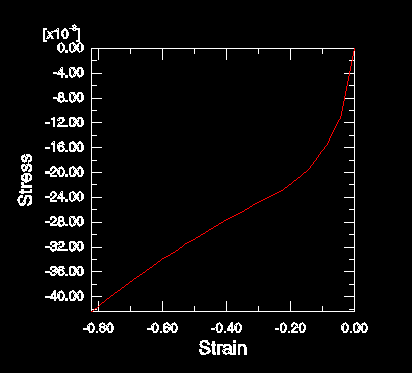Context:
The arguments of this operation are not commutative. If X-coordinate values for the two data objects do not match, Abaqus/CAE computes the missing data points to allow the X–Y data objects to be aligned. For more information on how missing data points are computed, see Understanding X–Y data interpolation and extrapolation.
A typical application of this function would be to combine a data object having X-values of time and Y-values of load with a data object having X-values of time and Y-values of displacement to produce a data object having X-values of displacement and Y-values of load. Another example would be to combine a data object having X-values of time and Y-values of stress with a data object having X-values of time and Y-values of strain to produce a data object having X-values of strain and Y-values of stress, as shown in Figure 1.
Figure 1. X–Y plot of stress versus strain.

Locate the Operate on XY Data dialog box.
From the main menu bar, select . Click Operate on XY data in the dialog box that appears; then click Continue. The Operate on XY Data dialog box appears.
From the Operators listed, click .
The function appears in the expression window.
From the XY Data choices, click the names of the two X–Y data objects to combine in the order you want Abaqus to combine them and click Add to Expression. Choices include all X–Y data objects previously saved within this session, listed alphabetically.
The X–Y data object names appear, separated by commas, within the function parentheses in the expression window.
To continue to build your expression, position the cursor in the expression window and type in or select the functions, operators, and X–Y data you want to include.
To evaluate and display your expression, click Plot Expression.
To save your new X–Y data object, click Save As and then provide a name in the dialog box that appears.
Saving your data object makes it available for future operations within this session and for inclusion in X–Y plots containing multiple data objects.
When you are finished, click Cancel to close the dialog box.
